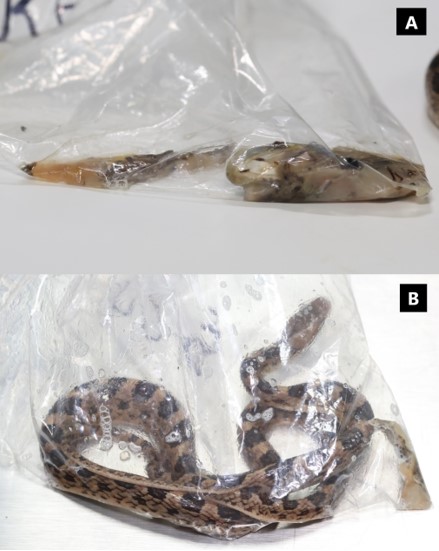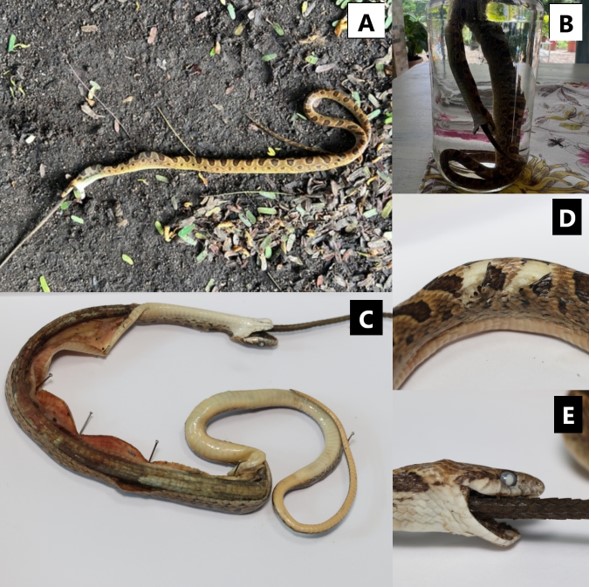

| Rogemif Fuentes 1 | Michelle Quiroz-Espinoza 1, 2 |
| https://orcid.org/0000-0002-4389-2665 | https://orcid.org/0000-0002-6955-4605 |
| 1Fundación Los Naturalistas, P.O. Box 0426-01459, David, Chiriquí, Panamá |
| 2Universidad Autónoma de Chiriquí. Instituto Interdisciplinario de Investigación e Innovación |
| Corresponding autor: rogemifdaniel@gmail.com |
| Enviado el 5 de junio de 2024. Aceptado el 18 de junio de 2024 |
| https://doi.org/10.59722/rcvn.v2i1.764 |
Snakes are predators that use various mechanisms to subdue their prey. The Leptodeira genus usually feeds on anurans and small saurians. Necrophagy, or feeding on dead or decaying organisms, is observed in some Neotropical snake species, including Leptodeira annulata, L. ashmeadii, L. ashmeadii, L. ashmeadii and L. rhombifera. This work presents two new reports of necrophagy in L. rhombifera. These observations highlight adaptive feeding behaviors in species of the genus Leptodeira.
Corpse, feeding, predator, prey, regurgitate.
Las serpientes son depredadores que utilizan varios mecanismos para someter a sus presas. El género Leptodeira suele alimentarse de anuros y pequeños saurios. La necrofagia, o alimentación de organismos muertos o en descomposición, se observa en algunas especies de serpientes neotropicales, incluyendo Leptodeira annulata, L. ashmeadii, L. ashmeadiiL. ashmeadii, L. splendida y L. rhombifera. En este trabajo presentamos dos nuevos informes de necrofagia en L. rhombifera. Estas observaciones destacan comportamientos alimenticios adaptativos en especies del género Leptodeira.
Alimentación, cadáver, depredador, presa, regurgitar.
Snakes are important predators that play a role as regulators and rely on multiple mechanisms to subjugate their prey (Savage, 2002). The genus Leptodeira spp. is commonly associated with the predation of anurans and small saurians (Duellman, 1958).
Necrophagy is a behavior observed in various animal species, including certain types of insects and vertebrates, where individuals feed on dead or decaying organic matter (Benbow, 2015). This has only been documented in the scientific literature in very few species of Neotropical snakes including L. rhombifera (Linnaeus, 1758), Leptodeira ashmeadii (Hallowell, 1845), Leptodeira rhombifera (Mora-Benavides, 1999; Knight, 2016; Céspedes & Abarca, 2014) and L. septentrionalis, L. splendida (Duarte et al., 2024). In this note, we present two new reports for Leptodeira rhombifera.
The night of May 7, 2024 at 00:48 in the province of Veraguas (7°24'42.3" N, 80°53'30.8" W) during a tour of the research project “Revisión filogenética y taxonómica de las serpientes ojo de gato (Leptodeira spp.) en Panamá” we collected the individual coded as RF-046 (MHCH-5047) crossing the road in an open area surrounded by grassland, which was transferred in a plastic bag to the laboratory of the Instituto Interdisciplinario de Investigación e innovación (i4), Vicerrectoría de investigación y postgrado, Universidad Autónoma de Chiriquí, where it would be prosecuted.
On May 21, 2024, at approximately 08:00 a.m. it was observed on the patio of Mr. Armando López's home, in Coronado, province of Panamá Oeste 8°32'01.6” N, 79°53'44.9” W, a dead cat-eyed snake (Leptodeira sp.), which had in its mouth the tail of what appeared to be a specimen of Basiliscus sp.
Through an informative poster of the same project, spread on social networks, Mr. López contacted the authors and provided the specimen to be part of the study, registering with the code RF-055 (MHCH-5056).
To verify the prey species, a necropsy was carried out that allowed its observation. We placed the animal in a supine position and made a paraventral linear cut in the first third of the snake's body with a sterile scalpel (Pessier & Pinkerton, 2003).
Specimen RF-046 is an adult male. Upon arrival at the laboratory, still inside the plastic bag, he regurgitated an individual of Leptodactylus labialis in two fragments. The first with the anterior part of the thorax and the second with part of the pelvic girdle and hind limbs, after 18 hours, at the time of being processed, we realized that the snake had once again eaten the largest fragment that it regurgitated (figure 1).

Figure 1. Leptodeira rhombifera RF-046. (A) Fragments of the regurgitated Leptodactylus labialis individual (B) Snake accompanied by the smallest fragment, after preying on the largest fragment again.
Specimen RF-055 (MHCH-5056) is an adult female, SVL 43.4 cm, tail 15.3 cm, it preyed on a tail fragment of a green iguana (Iguana rhinolopha) that measured 38.2 cm, the snake had bite marks (figure 2).

Figure 2. Leptodeira rhombifera RF-055. (A) Original photograph of the record (B) Specimen temporarily preserved to send the individual to the authors (C) Necropsy of the snake to verify the prey (D) Bite marks (E) Close-up face of predator and prey. Photos: Armando López (A, B), Rogemif Fuentes (C, D, E).
Discussion
When snakes are handled and moved from one place to another, they usually regurgitate food, due to the stress caused by the capture and transport (Zug et al., 2001). In this case, due to the requirement to be processed, specimen RF-046 was kept in the same bag for a long time, which allowed us to document the necrophagy event.
When we found the dead snake RF-055, we thought that the cause of death was choking. However, when we examined the animal, we noticed two holes, probably from fangs, so a pet dog may have captured the iguana, causing it to lose its tail which the snake was feeding later. We think that the same or another dog killed the snake since Mr. López confirmed that one of his dogs tends to hunt iguanas regularly.
We consider this event as necrophagy because the snake is feeding on a fragment of the iguana's tail and not the individual per se; the size of the fragment and its direction when ingested suggests that it was preyed upon after its detachment, eliminating the possibility that the snake attempted to directly hunt the iguana.
Unlike its congener L. septentrionalis, which feeds almost exclusively on anurans, L. rhombifera has a varied diet as it includes fish as well (Céspedes & Abarca, 2014; Solís & Guerrero, 2016), similarly to i>L. rubricata< (Solorzano, 2004; Sasa et al., 2009). Moreover, feeding on corpses of frogs ang lizard run over on roads has already been documented (Céspedes & Abarca, 2014; Knight, 2016; Duarte et al., 2024), which leads us to consider this behavior as widespread among snakes (DeVault and Krochmal, 2002) as supported by our records.
In L. septentrionalis, predation of internal organs of Smilisca phaeota was reported (Cope, 1862). This behavior represents a feeding adaptation observed in L. rhombifera (Arroyo-Trejos & Mora, 2016). Duarte et al. (2024) suggest that snakes of the genus Leptodeira likely depend on chemical signals, especially olfaction, to find food. However, DeVault and Krochmal (2002) argue that despite having venom glands, how these snakes administer venom to capture their prey is still unclear.
Despite being common, this is the first description of feeding on previously regurgitated prey and on a fragment of the tail of a species that was hunted by another predator. This study demonstrates that social networks can also serve as a valuable tool for capturing information and expanding our knowledge of wild animal behavior.
We thank to SENACYT for financing the project “Revisión filogenética y taxonómica de las serpientes ojo de gato (Leptodeira spp.) en Panamá” where we got the individuals for this report; to Ministerio de Ambiente de Panamá for the corresponding collection permit; to the Instituto Interdisciplinario de Investigación e Innovación (i4); to the Vicerrectoría de Investigación y Postgrado of Universidad Autónoma de Chiriquí, for providing the laboratories for this study; and to Mr. Armando López for facilitating the specimen RF-055 for the project as a community effort, through dissemination on social networks.